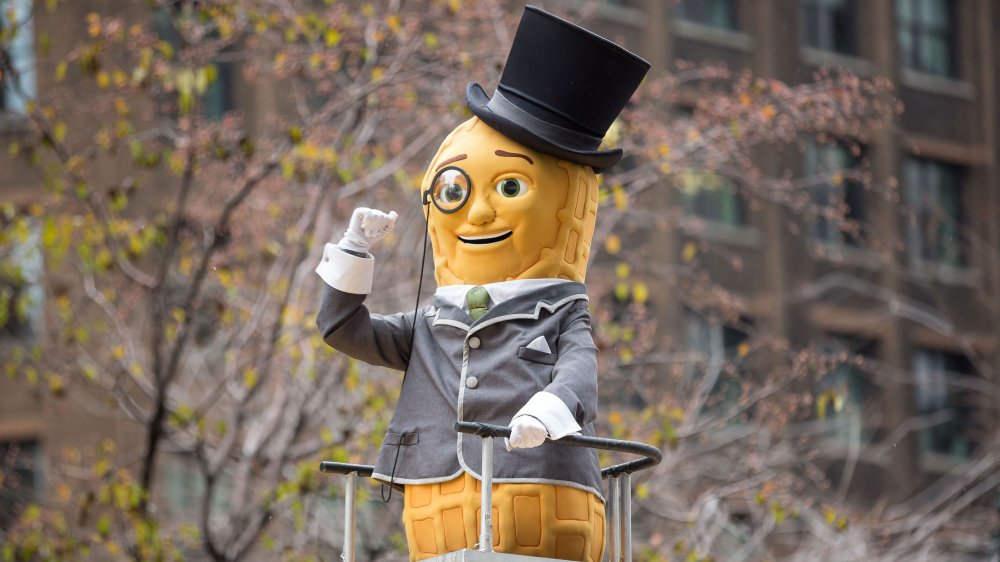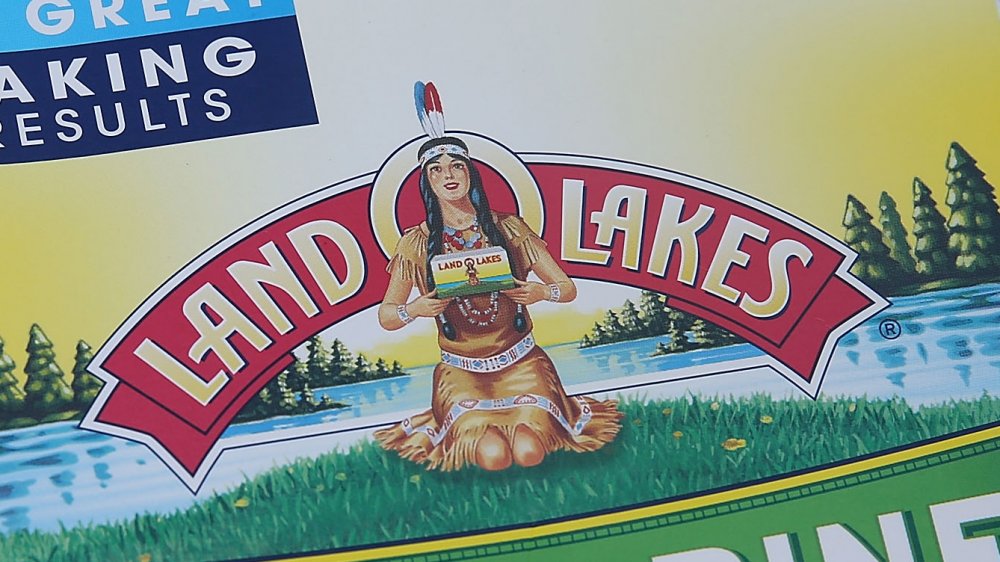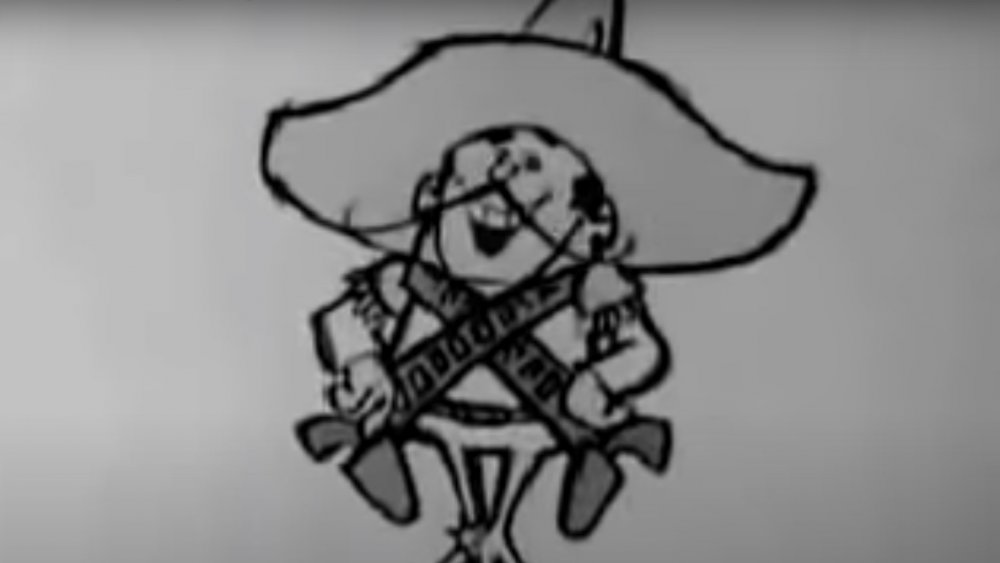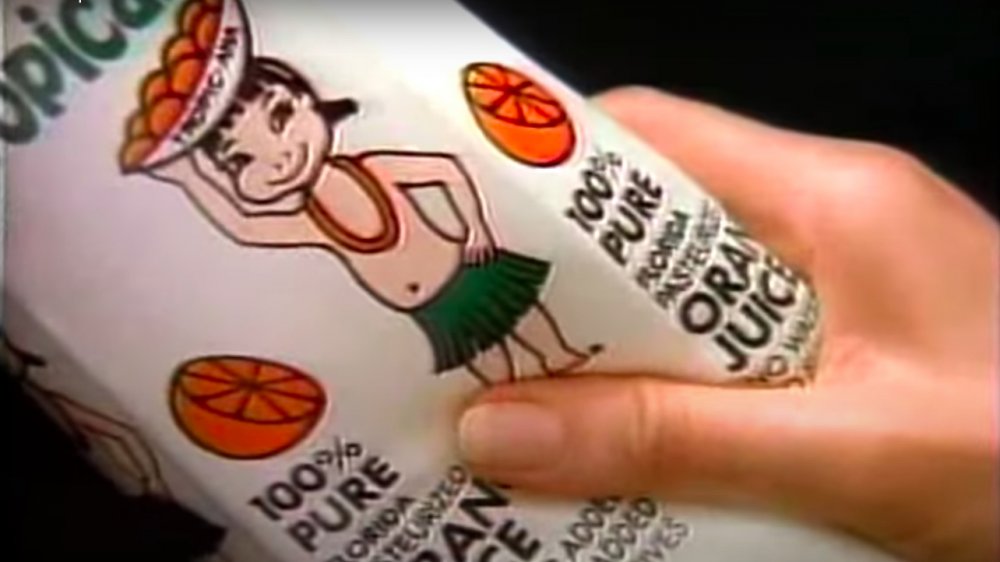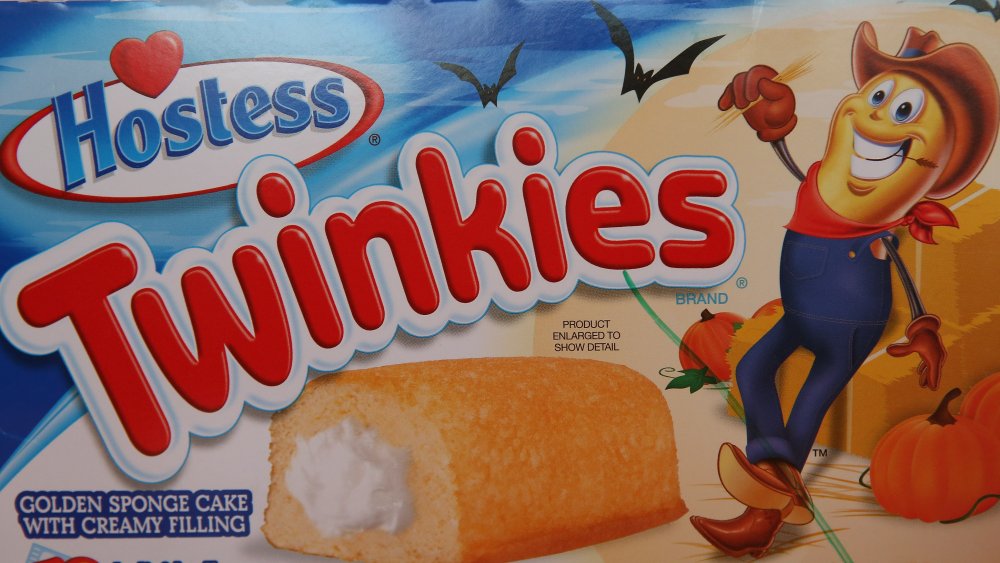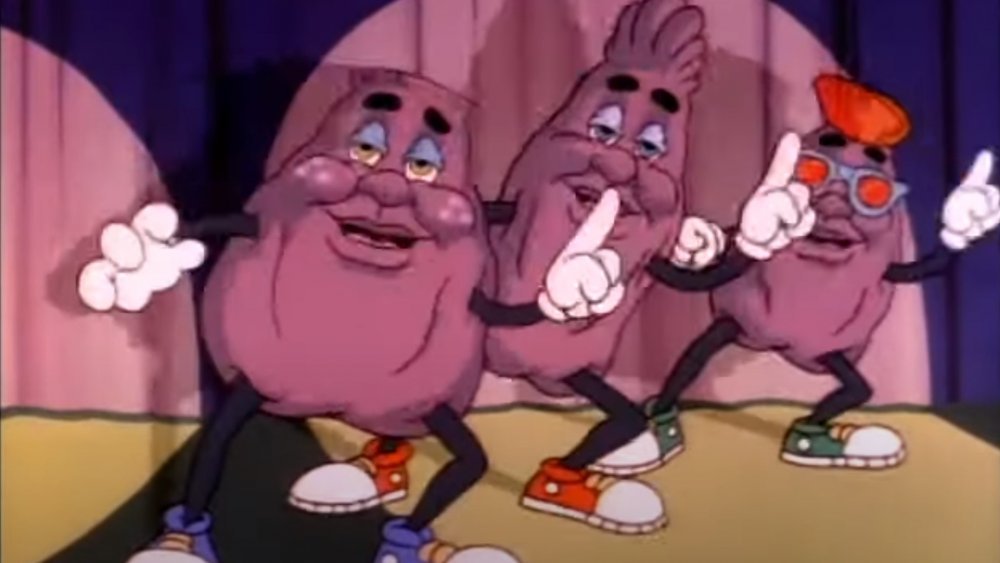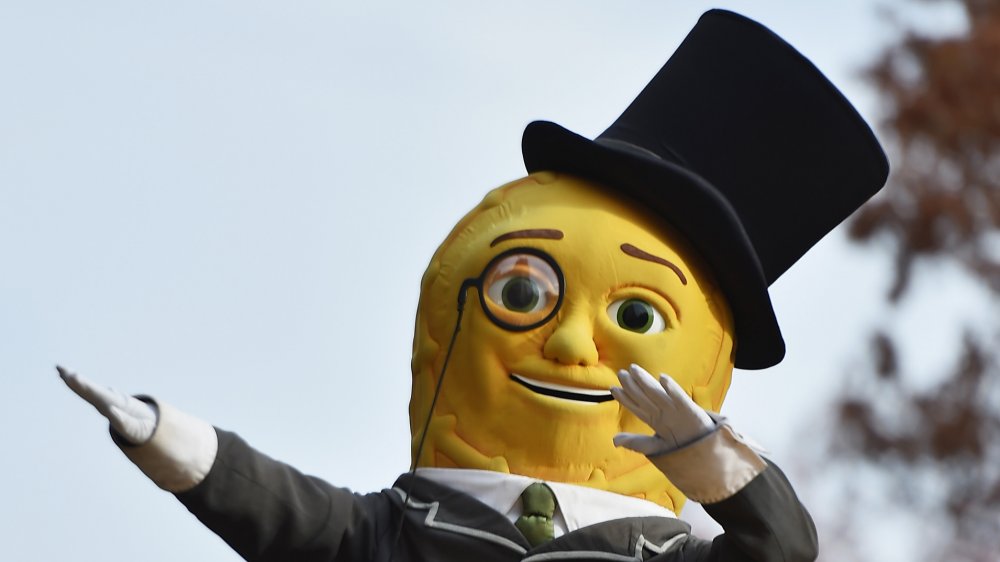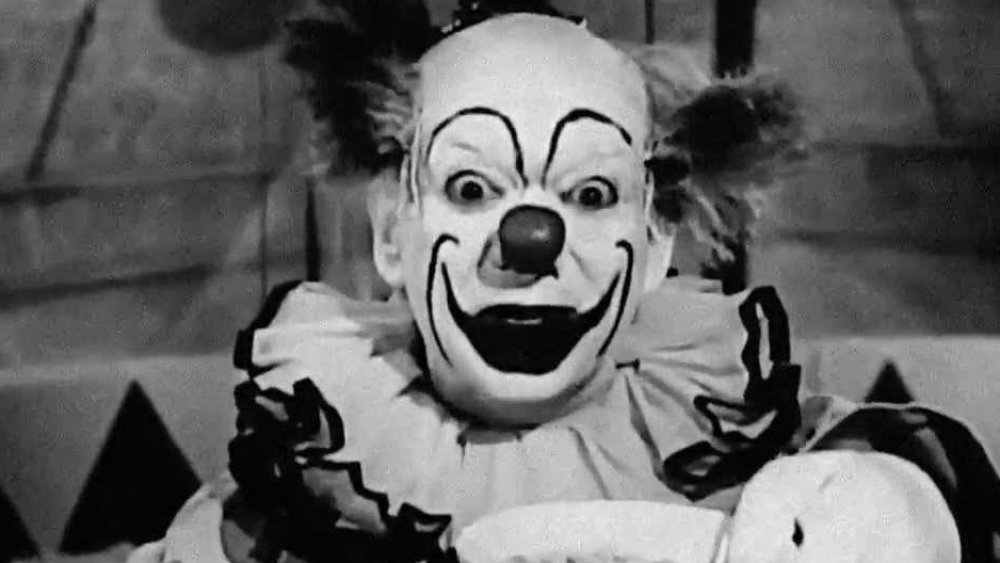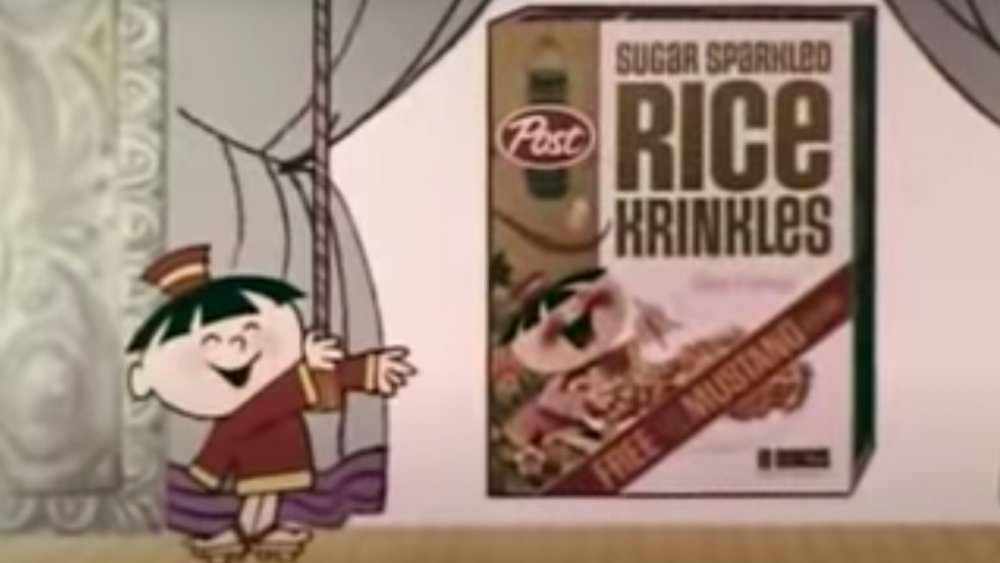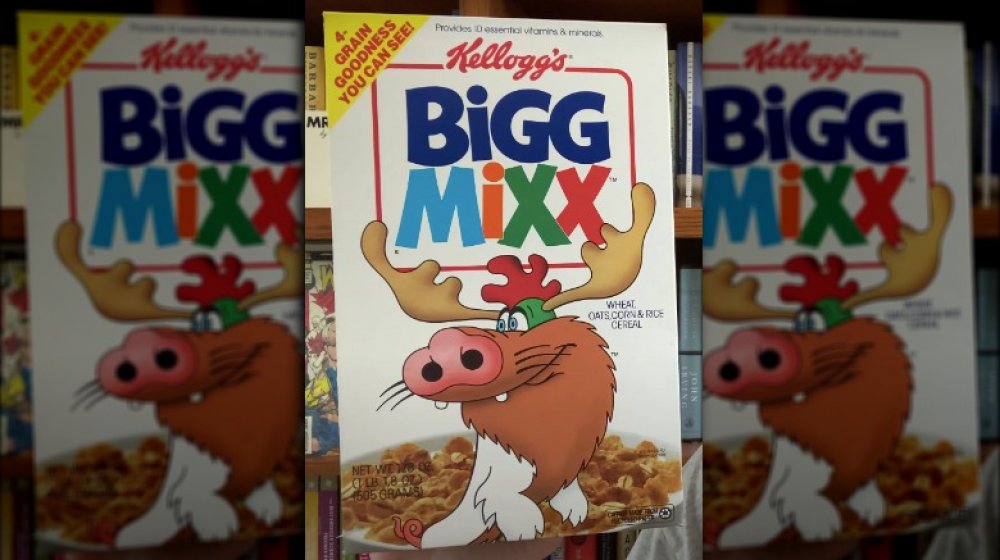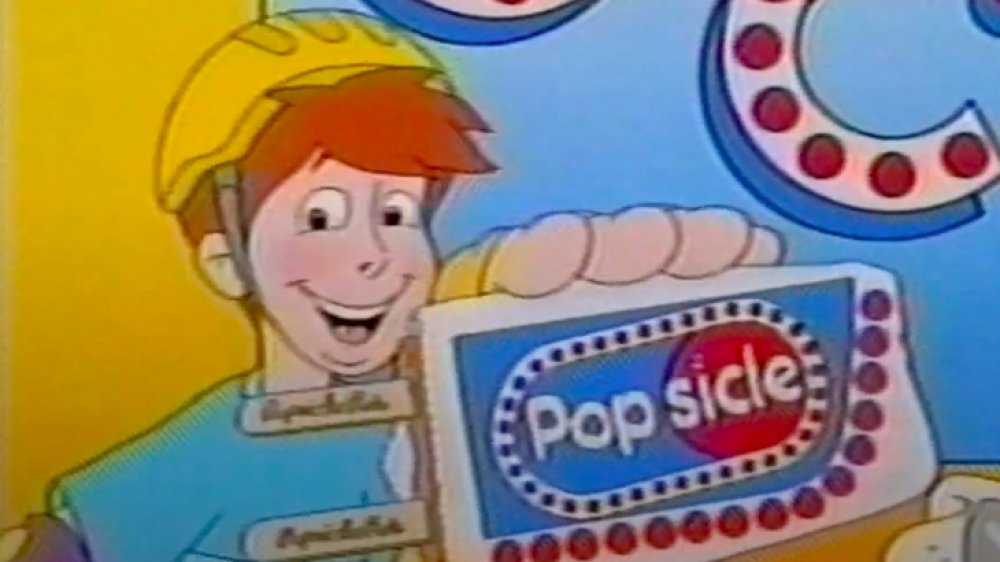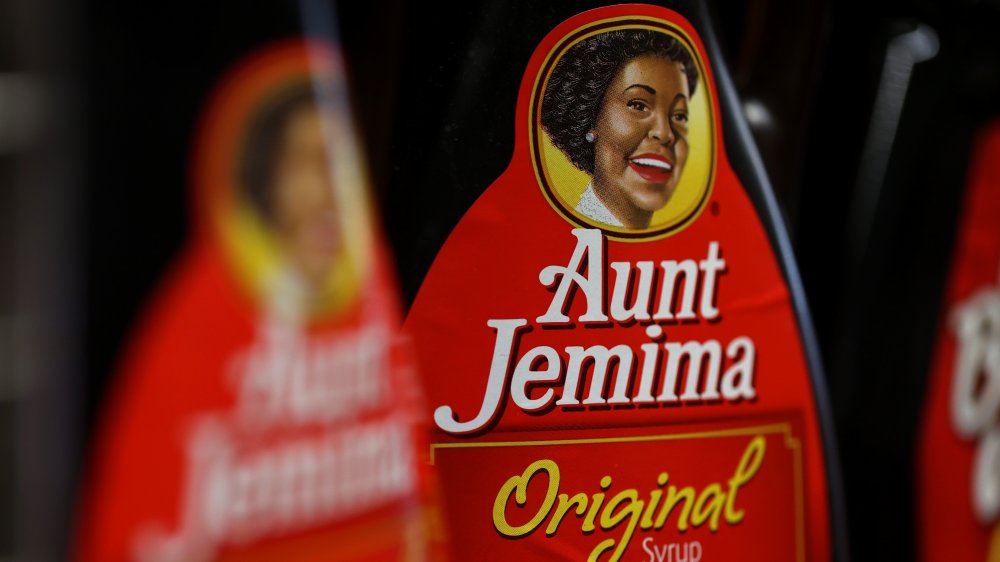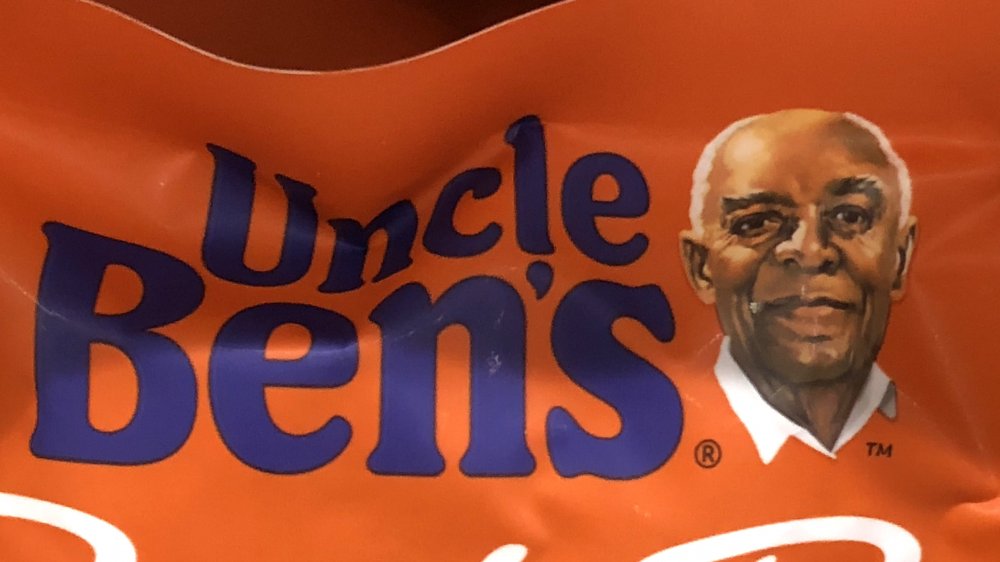The Real Reason You Don't See These Food Mascots Anymore
In the food world, mascots were once one of the most effective marketing gimmicks. In the early 20th century, these mascots — which were usually cartoon drawings —were often seen as amusing and endearing. Think: Tony the Tiger and the Keebler Elves. Sometimes, though, they were just plain creepy, like Quizno's Spongmonkeys, Burger King's lasciviously grinning king, or many of McDonald's horrifying mascots (and, for many people, that includes Ronald McDonald).
In 2020, we've seen several iconic food mascots criticized as racially insensitive, leading some companies to make an effort to change the mascot's appearance or retire it altogether. Of course, not all food mascots of old that disappeared on everything from cereal boxes and snack cakes were controversial. Some companies simply retired their brand mascots without controversy. Mashed did some digging and uncovered the real reason many iconic food mascots went away. Here's a look at some of the most famous mascots that are seemingly gone forever.
Land o' Lakes quietly retired Mia the mascot
In February 2020, the Native American woman known as "Mia" suddenly vanished without a trace from Land O'Lakes packaging. Mia has an interesting history. Historian Emily Heimerman explained in an article for Historically Speaking, 320 dairy farmers in early-1920s Minnesota formed the Minnesota Cooperative Creameries, which wasn't an especially catchy name. They held a contest for Minnesotans to come up with a new name that reflected the state's culture and history. The winner was Land O'Lakes, Inc. Next, it was time for a logo.
Inspired by the Native American legend of Hiawatha and Minnehaha, the artist, Arthur C. Nelson, painted "Mia" wearing buckskin, beads, and feathers, holding a tub of butter aloft. In the late 1950s, Ojibwe artist Patrick DesJarlait redesigned Mia with the intention of "fostering a sense of Indian pride." Over the years, however, many Native Americans became increasingly incensed by "symbols of the European-American narrative that ignores the genocide, disease, and cultural devastation brought to our communities" (via National Geographic).
In 2005, the American Psychological Association issued a resolution that all "American Indian mascots, symbols, images, and personalities" be retired because such symbols "[appear] to have a negative impact on the self-esteem of American Indian children." However, it wasn't until February 2020 that the brand unveiled its new packaging — without Mia — "to better tell its farmer-owned story." In a tweet, Minnesota Lieutenant Governor Peggy Flanagan thanked the brand "for making this important and needed change."
Frito-Lay finally retired Frito Bandito after years of complaints
In the late '60s, you couldn't turn on your television without seeing the Frito Bandito. The advertising agency responsible for the ad campaign hired Tex Avery — the famous cartoonist who created Bugs Bunny, Daffy Duck, and Porky Pig — to bring the Frito Bandito to life. "Speaking broken English, he robbed people of their Fritos, a reference to the 'Mexican bandit' stereotype in Westerns," the National Museum of American History explained. Legendary voice actor Mel Blanc gave voice to the Frito Bandito.
With an onslaught of merchandising and rewritten lyrics to the Mexican song "Cielito Lindo" ("Ai, yi, yi, yi, I am the Frito Bandito"), the Frito Bandito was very popular. But not everyone was amused. The National Mexican-American Anti-Defamation Committee (NMAADC) and Mexican-Americans in Gainful Endeavors (IMAGE) threatened organized boycotts of Frito-Lay products until the company ceased using what they considered to be a negative depiction. Frito-Lay initially dug in its heels. "We don't need the flak if the Bandito wasn't selling Fritos," a company exec is quoted as having said.
A year later, though, the NMAADC — teamed with other Mexican-American advocacy groups — filed a $610 million class-action suit for malicious defamation of every person of Spanish-speaking ancestry in the United States. Finally, in 1971, Frito-Lay backed down and laid Frito Bandito to rest.
Tropicana replaced its mascot after decades of use
In the 1940s, Sicilian immigrant Anthony Rossi found success in New York City selling boxed fruit, according to The New York Times. He decided to relocate to Florida where he could buy fruit directly from the growers and began shipping freshly-squeezed orange juice throughout the United States. As his business — then called Fruit Industries, Inc. — burgeoned, he figured out a way to extract water from juice for making frozen orange juice concentrate, which he dubbed "Tropicana."
In 1951, Rossi commissioned artist Jane Beckley Burt to create a brand mascot for Tropicana. Jane's sketches turned into Tropic-Ana, a nonspecific island native girl whom she based on her son's friend, Christine Keston Pool, according to the Bradenton Herald. Tropic-Ana wore only a grass skirt and a lei strategically positioned on her bare chest. Holding a bowl of oranges atop her French-braided hair, Tropic-Ana represented Tropicana for nearly four decades.
Tropic-Ana wasn't really given a second thought as she came to be during a time when racially-insensitive product mascots were the norm. However, "Tropic Ana symbolized a widespread view of superiority over indigenous peoples the world over ... that underscored the colonialist/manifest destiny idea that the natives' exist only to serve the American way of life," the American Institute of Graphic Arts explained. In 1988, Seagram purchased Tropicana and although there is no indication the company considered Tropic-Ana controversial, she was sent packing and replaced with Tropicana's now-familiar straw-in-orange logo.
Twinkie the Kid made a comeback before eventually disappearing for good
The Twinkie was invented in 1930 by James A. Dewar, the manager of Continental Baking, The New York Times revealed. Twinkies were originally filled with banana cream, but during World War II, bananas were scarce, so Continental switched to the now-iconic vanilla cream filling, which was an instant hit. In the 1950s, Continental signed on as a sponsor for The Howdy Doody Show, and Twinkies were directly marketed to children.
In the '70s, Continental launched a new ad campaign with the debut of Twinkie the Kid, a walkin'-talkin'-lasso-twirlin' Twinkie in cowboy gear. With the slogan "you get a big delight in every bite," the Kid was a sensation. Continental followed up with other anthropomorphized bakery goods, but Twinkie the Kid was the most popular. With people seeking out healthier food options in the1980s and 1990s, though, snack cakes began to fall out of favor. Declining sales and mismanagement had plagued Continental for years and in 2004, the company declared bankruptcy.
Hostess emerged in 2009, now called Hostess Brands, and attempted to market smaller portions, like the 100-calorie Twinkie Bites, but it was a bust, and Hostess Brands shut down in 2012. Hostess Brands reemerged in 2013 — and an updated Twinkie the Kid showed up on packaging and even made personal appearances. But the Kid's comeback was short-lived. In 2017, Hostess refocused its marketing to target millennial moms instead of their kids, and Twinkie the Kid rode off into the sunset.
The California Raisins were just too expensive
In 1986, Marvin Gaye's "I Heard It Through The Grapevine" was playing on the airwaves again, thanks to the hit film The Big Chill. According to Mental Floss, copywriter Seth Werner of ad agency Foote, Cone & Belding pitched an outlandish idea to the California Raisin Advisory Board (CALRAB): raisins singing and dancing to "Grapevine." Animator Will Vinton brought the raisins to life using Claymation and on September 14, 1986, the first commercial featuring The California Raisins aired.
With their slick haircuts and ultra-stylish shoes, The California Raisins were a phenomenon. "The Raisins really put us and Claymation on the map," Vinton told Food & Wine. Raisin sales increased by 20 percent following the first commercial, according to Mental Floss. The California Raisins recorded four albums — their cover of "Grapevine" was a top 100 Billboard hit — and were nominated for an Emmy Award. Ray Charles was given the Claymation makeover in a California Raisins commercial in which he sings his version of "Grapevine" with sultry, soulful lady raisins.
Nevertheless, the Claymation commercials were costly and time-consuming to produce. When CALRAB folded in the mid '90s, the California Raisins Marketing Board (CRMB) took over marketing the Raisins. According to Farm Progress, CALRAB had a $20 million budget for promoting raisins, but the new CRMB received only $6 million. CRMB couldn't afford to spend their limited budget on Claymation commercials. And so, in 1994, the California Raisins officially retired.
Planters killed off Mr. Peanut
In 1916, the Planters Peanut and Chocolate company held a contest for a trademark and selected 14-year-old Antonio Gentile's simple sketch of a jaunty peanut walking with a cane, Smithsonian revealed. Planters spiffed up Gentile's original by giving Mr. Peanut a top hat, monocle, gloves, and spats, according to Contingent Magazine, and he remained that way for 104 years. According to Mental Floss, Planters held a contest in 2006 to change Mr. Peanut's fancy duds, but fans voted to keep him as he always was.
In Planters' 2019 Super Bowl commercial, Mr. Peanut can be seen zooming down city streets in his Nutmobile to stop Alex Rodriguez from eating kale chips. In 2020, Planters' advertising agency, VaynerMedia, wanted an even bigger event. As reported by CNBC, agency executives were inspired by the reaction on social media to — spoiler — Iron Man's death in Avengers: Endgame to devise a scenario in which Mr. Peanut dies while sacrificing his life for others. (Ironically, Robert Downey, Jr. gave voice to Mr. Peanut in 2010.)
The unusual commercial killed off Mr. Peanut and introduced a Baby Yoda-ish Baby Nut in his stead. VaynerMedia heavily promoted Mr. Peanut's funeral, scheduled for the third quarter of the Super Bowl. But when Kobe Bryant died in a helicopter crash before the Super Bowl, Business Insider reported that VaynerMedia temporarily suspended part of the campaign. However, Mr. Peanut's funeral was still aired at the Super Bowl, and Baby Nut officially became the new face of Planters.
Post sent Krinkles the Clown back to the sewers
Dubbed by BuzzFeed as "the most terrifying cereal mascot ever," Krinkles the Clown first appeared in 1956 on the box of Post's then-new cereal, Sugar Rice Krinkles, essentially a hybrid of Rice Krispies and Frosted Flakes. Post made one television commercial starring Krinkles the Clown and, well, it has to be seen to be believed.
The audience is introduced to Krinkles as he bursts out of what appears to be a doghouse and crashes through a paper wall, growling "I'm hungry!" He stomps to a breakfast table to devour a large bowl of Sugar Rice Krinkles, maniacally telling us "It's so good, I kah-rinkle every time I eat it!" With a clown mascot that rivals Stephen King's killer clown Pennywise, it's not surprising that Sugar Rice Krinkles failed to catch on.
In the 1960s, Bozo the Clown became the most popular clown around. Perhaps inspired by his success, Post took another stab at using a slightly less homicidal clown as their brand mascot in 1968 — but the results were much the same as before.
Post eventually said goodbye to So-Hi
Post relaunched its Sugar Rice Krinkles as Sugar Sparkled Rice Krinkles (alternately Sugar Coated Rice Krinkles) in 1959. Having ditched the incredibly creepy clown, the brand introduced a new mascot: a small Asian boy named So-Hi — referring to his short stature, not a hallucinogenic state. As Mental Floss mused, So-Hi "spouted charmingly pronoun-less phrases ... with a few 'Ah-so's' thrown in for good measure."
So-Hi came to be during an era in which Asian Americans were frequently mocked and ridiculed in film and television, and he remained a popular mascot for Sugar Sparkled Rice Krinkles for almost ten years. Just as cringe-worthy were the toy prizes buried in each box, like a rickshaw racer. Post eventually jettisoned So-Hi in 1968, and according to The Consumerist, it's unclear whether they did so just to market the cereal differently or were newly conscious of offending their Asian consumers.
Bigg Mixx went to live on the farm in the '90s
One of the weirdest food mascots was Bigg Mixx, a Frankenstein creation of a chicken, moose, pig, and wolf. As CBS News explained, this patchwork creature was supposed to represent the mixed-up nature of Kellogg's new cereal that contained rolled oats, rice, corn flakes, and whole-grain wheat — basically a conglomeration of other Kellogg's cereals.
The cereal box design featured Bigg Mixx and his clever origin story. As retold by Mr. Breakfast, the mascot was purportedly first spotted in Yakima, Washington in 1978. "Since then, there have been countless other sightings — in the woods, at shopping malls, and even once on a subway in New York City (unconfirmed)," read the box.
Kellogg's heavily promoted the Bigg Mixx character with prizes and promotional giveaways. Commercials were just as oddball as Bigg Mixx himself. In one ad, a mother talks to the camera while her son gobbles down the cereal with clucking sounds. "Billy loves raisins," she says. "He's part-chicken, you know." The wacky advertising campaign failed, and the cereal never caught on, and Bigg Mixx was retired in 1992. It's said that he still wanders the Yakima woods.
Popsicle Pete is all but forgotten
Popsicle's long-time brand mascot was Popsicle Pete, introduced in 1939 on an episode of the Buck Rogers in the 25th Century radio show as a "Typical American Boy." Crimson-haired Pete was created by cartoonist Woody Gelman, who would later co-create "Bazooka Joe" in the 1950s for Bazooka Bubble Gum. Popsicle Pete appeared in newspaper ads, Popsicle wrappers, and promotional giveaways, like the Popsicle Pete Fun Book, which contributed to the character's popularity and longevity.
Other Popsicle characters showed up, too, but Pete was the official mascot for some five decades. However, in 1986, Popsicle was in fierce competition with other frozen treat companies, The New York Times explained. And, as Popsicle Industries President Rupert Walker told the publication, there was another problem: "People find the twin stick inconvenient. It falls apart, it's messy."
The company ditched the second stick and refocused its marketing efforts to target parents "to awaken the memories that most adults have of bygone summer days eating Popsicles and to transfer those memories to today's children," The New York Times continued. In 2020, Popsicle's parent company, Unilever, cited a 2016 World Health Organization report about obesity in children and announced they were halting all advertising and marketing directed at children under 12, CBS News reported. Popsicle Pete had pretty much already disappeared by this point in time, but with Unilever's new policy, he will live on only in memory.
The Aunt Jemima brand and mascot are both being retired
Quaker Oats' Aunt Jemima character was inspired by a minstrel show, which were usually performed by white actors in blackface. Jemima's fictionalized backstory was that she was a loyal cook to a Confederate colonel and plantation owner, whom she helped escape from capture by cooking pancakes for Union soldiers. Per The New York Times, Aunt Jemima was dubbed "the cook whose cabin became more famous than Uncle Tom's."
In 1890, Nancy Green — a woman who was born into slavery, won her freedom, and became a cook and housekeeper to a wealthy Chicago family — was recruited to portray Aunt Jemima at the 1892 World's Columbian Exposition. Green's recipe for self-rising pancakes were favorites of the Chicago family children and family friends. During the Exposition — and later on tour — Green dressed as a "mammy," who reminisced about her days cooking flapjacks on the plantation. Green passed away in 1926, but the Aunt Jemima character persisted, most notably on Quaker Oats' pancake boxes and syrup bottles.
Quaker Oats changed its Aunt Jemima logo six times before retiring the visage, reported Business Insider. The last iteration, pictured above, portrayed a middle-aged Black woman with perfectly coiffed hair, pearl earrings, and a large smile. Ultimately, in June 2020, Quaker Oats announced, "We recognize Aunt Jemima's origins are based on a racial stereotype." The company plans to change the brand name and image.
Uncle Ben's mascot will likely change
Within hours of Quaker Oats' announcement to replace its Aunt Jemima name and logo, Mar's, Inc. put out a press release about its Uncle Ben's brand and image, saying that it "recognize[s] that now is the right time to evolve the Uncle Ben's brand, including its visual brand identity." Although "the Uncle Ben's story" has been wiped from its American website, it can still be found on Uncle Ben's Australian site.
According to the company, founders of the original business, Converted Rice, renamed their product after a Texas farmer known as Uncle Ben, who was famous for his rice. It's not known if the Texas farmer actually existed. However, the Houston Chronicle (via The Takeout) explained that the use of the word "uncle" was "a disparaging way to refer to Black men, in lieu of 'Mr.' (and 'aunt' for 'Mrs.' or 'Ms./Miss')."
The brand image is that of Frank Brown, a restaurant maître d' who posed for his portrait for $500, The Takeout reported. Uncle Ben didn't change until 2007 when Mars, Inc. announced that he was now called "Ben" and promoted to chairman, according to The New York Times. "This is an interesting idea," Luke Visconti of Diversity, Inc. told the publication, "but for me, it still has a very high cringe factor. There's a lot of baggage associated with the image." As of this writing, Mars, Inc. has not set a schedule for when or how the brand mascot and name will change, but as of June 2020, the company began "evaluating all possibilities."
